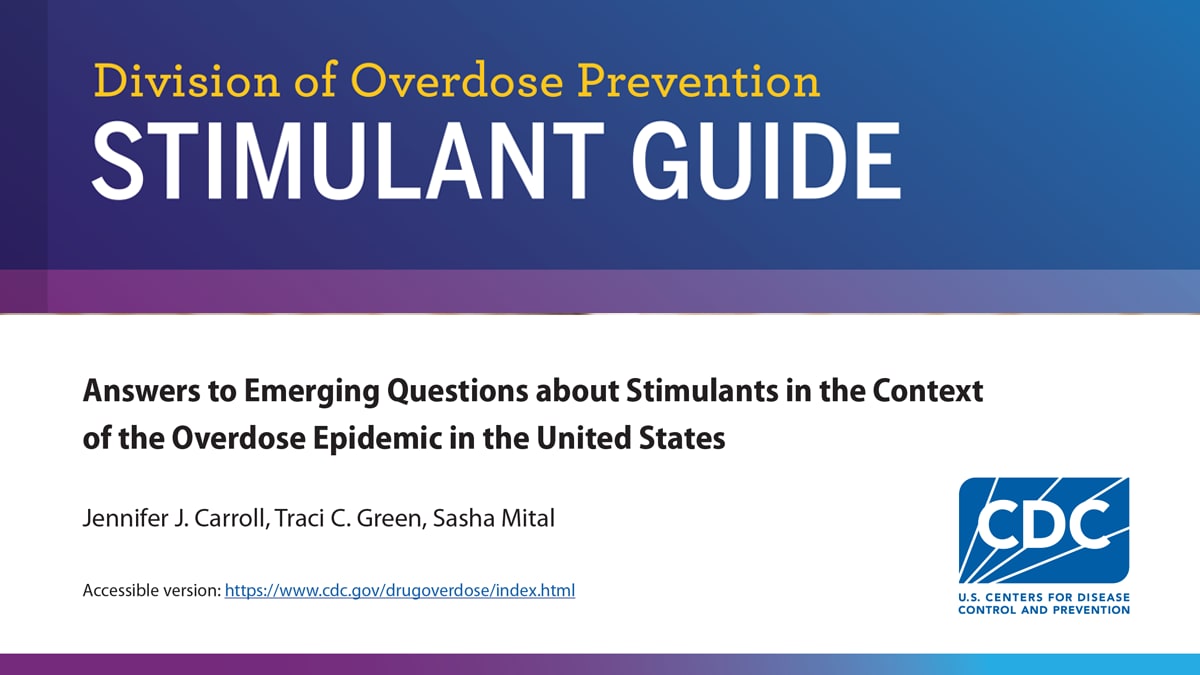At a glance
- Stimulants include drugs such as methamphetamine, other amphetamines, and cocaine.
- Stimulant-involved overdose deaths have risen in recent years.
- View our Stimulant Guide below to learn more about risks, how to identify a stimulant overdose, and how to access resources for further support or education.
What are stimulants?
Stimulants affect the central nervous system and can cause cardiovascular complications (e.g., stroke, myocardial infarction), affect the body's ability to regulate body temperature, and lead to mental health problems. Long-term stimulant use is associated with cardiovascular disease, which can result in higher risk of stimulant overdose.12
Cocaine, methamphetamine, and MDMA (or "ecstasy") are examples of illegal stimulants. Prescription stimulants such as amphetamines (e.g. Adderall Dexedrine) and methylphenidate (e.g. Concerta, Ritalin) can be used to treat ADHD and other disorders. Prescription stimulants, drugs used to treat conditions such as attention deficit hyperactivity disorder (ADHD) or depression, can also be misused but do not tend to cause overdose. Approximately 3.9 million people aged 12 or older misused prescription stimulants in 2023.3
All psychostimulants are stimulants, but not all stimulants are psychostimulants. In the type of data coding that is often used for tracking overdose deaths (ICD-10), stimulants are captured largely under two main groupings: cocaine and psychostimulants with abuse potential. Methamphetamine is classified under "psychostimulants with abuse potential". Although this category also includes other stimulants such as amphetamine and MDMA, methamphetamine accounts for the majority of deaths in the category.
In 2023, nearly 60,000 overdose deaths involved cocaine and/or psychostimulants with abuse potential (mostly methamphetamine), which translates to about 57% of the 105,007 total overdose deaths in the US that year.4 Importantly, these drug categories (cocaine and psychostimulants with abuse potential) cover most but not all stimulant drugs, so the percentage of deaths involving any stimulant in 2023 is likely slightly higher.4
Cocaine
Cocaine is an illegal, highly addictive central nervous system stimulant that can be snorted, smoked, or dissolved and injected into a vein.
In 2023, 5 million Americans aged 12 or older reported using cocaine in the past year.3
Cocaine-involved overdose death rates in the United States decreased from 2006 to 2010 but have since increased. From 2022 to 2023, the number of overdose deaths involving cocaine increased by nearly 7%, with about 30,000 Americans dying in 2023 from an overdose involving cocaine.4
Methamphetamine
Methamphetamine (referred to as "meth," "ice," "speed," "crystal," and other terms) is a highly addictive central nervous system stimulant.5 In addition to risking becoming addicted to methamphetamine, people who use it long-term may experience a range of negative health outcomes, including damage to the heart and brain, anxiety, confusion, insomnia, mood disturbances, and violent behavior.6
In 2023, 2.6 million Americans aged 12 or older reported using methamphetamine in the past year.3
In the data coding that is often used for tracking overdose deaths (ICD-10 death coding), methamphetamine is classified as a "psychostimulant with abuse potential." This category also includes other stimulants such as amphetamine and MDMA; however, methamphetamine accounts for the majority of deaths in the category.
In 2023, nearly 35,000 drug overdose deaths involved psychostimulants with abuse potential, an approximately 2% increase from the previous year.4
Treatment for stimulant use disorders
For information on treatment, see SAMHSA's Treatment for Stimulant Use Disorders, or call 1-800-662-HELP (4357).
Learn more about stimulant use:
The Stimulant Guide
It is important that community service providers and members of the public have access to information about stimulants to increase awareness of the risks stimulants may pose, how to identify a stimulant overdose, and what resources exist to provide further support or education.
Our Stimulant Guide will answer some common questions about stimulants, stimulant use, stimulant overdose, and stimulant overdose prevention strategies developed by harm reduction experts.

- Centers for Disease Control and Prevention. A Stimulant Guide: Answers to Emerging Questions about Stimulants in the Context of the Overdose Epidemic in the United States. National Center for Injury Prevention and Control, Centers for Disease Control and Prevention, U.S. Department of Health and Human Services, 2022. https://www.cdc.gov/overdose-prevention/media/pdfs/2024/03/CDC-Stimulant-Guide.pdf
- Substance Abuse and Mental Health Services Administration. Treatment for Stimulant Use Disorders. Treatment Improvement Protocol (TIP) Series 33. SAMHSA Publication No. PEP21-02-01- 004. Rockville, MD: Substance Abuse and Mental Health Services Administration, 2021. https://www.ncbi.nlm.nih.gov/books/NBK576541/.
- Substance Abuse and Mental Health Services Administration. (2024). Key substance use and mental health indicators in the United States: Results from the 2023 National Survey on Drug Use and Health (HHS Publication No. PEP23-07-01-006, NSDUH Series H-58). Center for Behavioral Health Statistics and Quality, Substance Abuse and Mental Health Services Administration. https://www.samhsa.gov/data/sites/default/files/reports/rpt47095/National%20Report/National%20Report/2023-nsduh-annual-national.pdf
- Garnett MF, Miniño AM. Drug overdose deaths in the United States, 2003–2023. NCHS Data Brief, no 522. Hyattsville, MD: National Center for Health Statistics. 2024. DOI: https://dx.doi.org/10.15620/cdc/170565.
- Barr AM, Panenka WJ, MacEwan GW, et al. The need for speed: an update on methamphetamine addiction [PDF]. J Psychiatry Neurosci. 2006;31(5):301-313.
- Substance Abuse and Mental Health Services Administration. Stimulants.
- Patterns and Characteristics of Methamphetamine Use Among Adults — United States, 2015–2018
- Centers for Disease Control and Prevention. State Unintentional Drug Overdose Reporting System (SUDORS). Final Data. Atlanta, GA: US Department of Health and Human Services, CDC; May 2025. Access at: https://www.cdc.gov/overdose-prevention/data-research/facts-stats/sudors-dashboard-fatal-overdose-data.html